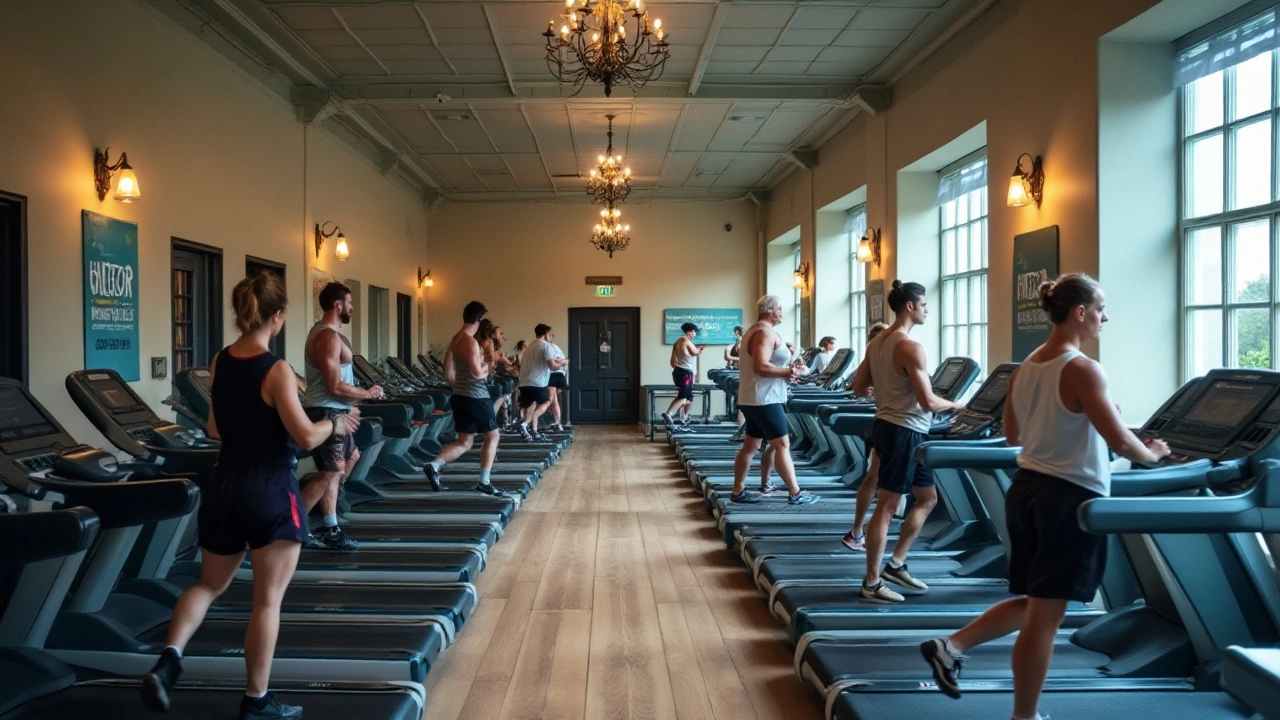
Losing weight and staying fit often brings up the question: how can you burn 1000 calories a day? While it might sound challenging, with dedication and the right mix of exercises, it's a target that many can reach. Burning such a significant amount requires a thoughtful approach, mixing intensity and consistency.
This guide will explore the science behind calorie-burning, including various high-impact workouts such as High-Intensity Interval Training (HIIT). We'll delve into cardiovascular exercises that not only torch calories but also improve stamina and heart health. Additionally, the role muscle building plays in boosting metabolism and long-term calorie burn will be covered, giving a balanced view of how to achieve your daily goal effectively.
Each section will provide insights tailored to different fitness levels, so find your pace and let's embark on this journey towards burning those 1000 calories a day.
- Understanding Calorie Burn
- High-Intensity Interval Training (HIIT)
- Incorporating Cardio Exercises
- Strength Training and Muscle Building
Understanding Calorie Burn
When you're on a journey to burn 1000 calories a day, understanding the nuances of calorie burn is key. Calorie burn is not just about hitting the treadmill or lifting weights; it's a complex process where every aspect of your lifestyle, including your diet, stress levels, and even sleep, plays a pivotal role. The science behind calorie burn involves both Basal Metabolic Rate (BMR) and physical activities. BMR is the number of calories your body needs to maintain basic physiological functions like breathing, circulation, and cell production. This baseline is crucial because it accounts for about 60-75% of your daily calorie expenditure, even when you're resting.
When considering exercise as a method to burn 1000 calories a day, it's vital to recognize which activities offer the highest return on your effort. For instance, activities like running, cycling, and swimming can significantly elevate your heart rate, resulting in higher calorie expenditure during and even after the workout. The concept of the 'afterburn effect', scientifically known as excess post-exercise oxygen consumption (EPOC), describes the additional calories your body burns after intense exercise as it returns to its resting state. This effect can be maximized with interval training and high-intensity routines, making them popular among fitness enthusiasts.
Different bodies burn calories differently, influenced by factors like age, gender, weight, and fitness level. Men typically have higher muscle mass than women and therefore, often have a higher BMR. Meanwhile, younger individuals and those with more lean muscle tend to have a faster metabolism than their older or less muscular counterparts. Did you know that by simply adding strength training to your routine, you can increase your muscle mass, thereby elevating your BMR naturally? Building muscle helps your body burn more calories at rest, thus contributing to reaching that 1000-calorie daily burn.
As you embark on this goal, it’s beneficial to remember the importance of combining both intensity and variety in your workouts. Cardiovascular exercises might be your go-to choice for burning large amounts of calories quickly, but including strength training in your regimen can enhance your metabolism long term. Moreover, activities that you enjoy doing are more likely to be sustainable in the long run. Exploring the activities you love helps keep your motivation high, making it easier to maintain consistency in burning calories.
"The best exercise is the one you love because you'll do it more often," says Dr. Kattoflis, a renowned fitness expert. By choosing exercises that resonate with your interests, you align motivation with action, making those 1000 calories a tangible daily goal.
Maintaining a close watch on your calorie expenditure requires appropriate tools and mindful tracking. Investing in a quality fitness tracker or utilizing apps that monitor heart rate and calorie burn offers insights into your progress. These tools help tailor your workouts to ensure efficiency in achieving your calorie goals. Regular assessment and adjustment of your exercise plans based on collected data can significantly enhance your success rate, helping meet those fitness milestones systematically and effectively.

High-Intensity Interval Training (HIIT)
High-Intensity Interval Training, commonly known as HIIT, has revolutionized the way we approach fitness by presenting a method that combines rigorous exercise with brief rest periods. This type of training pushes your limit, ensuring you maximize calorie burn in a significantly shorter time compared to traditional workouts. The core principle of HIIT is to engage in bursts of high-intensity moves like sprints or squats followed by short recovery phases. This pattern keeps your heart rate elevated, boosting your metabolism and enhancing fat oxidation far beyond the time spent exercising. It's fascinating how such a strategy helps you incinerate calories not only during your workout but up to 48 hours after completion!
HIIT is versatile and can be adapted to various forms of exercise, from cycling and running to bodyweight exercises like burpees and lunges. A typical session could include a series of exercises such as 30 seconds of sprinting or intensive jumps, immediately followed by a 15-second cool-down. This cycle is repeated for a duration that suits your fitness level, making it accessible yet challenging for everyone. According to the American College of Sports Medicine, HIIT can improve both aerobic and anaerobic fitness, which is crucial for overall health and longevity. Researchers have found that even sessions as brief as 15 to 30 minutes can yield substantial health benefits equivalent to longer traditional workouts, a testament to its efficacy.
The appeal of HIIT lies not just in its time efficiency, but also in its capacity to be tailor-made. Beginners might start with lower intensity and longer rest intervals, gradually increasing intensity as they build stamina. Meanwhile, seasoned fitness enthusiasts can push their boundaries further by incorporating equipment like kettlebells or resistance bands to their regimen. Whether working out at home with a yoga mat or at the gym with state-of-the-art equipment, HIIT offers a flexible structure adaptable to any setting.
"HIIT is a game-changer," states Dr. Martin Gibala, a renowned exercise physiologist, "allowing individuals with tight schedules to reap the benefits of intense exercise in less time." His research underscores the profound impact HIIT can have on metabolic and cardiovascular fitness, even with minimal weekly sessions.
Among the many attributes that make HIIT a compelling choice for many are the afterburn effect, also known as excess post-exercise oxygen consumption. This phenomenon means your body continues to burn calories well after the workout is over, making it a powerful tool in weight management strategies. Studies published by the Journal of Sports Science & Medicine point out that HIIT can effectively reduce visceral fat, a stubborn type of fat stored around internal organs, more effectively than moderate-intensity exercises.
To embark on a HIIT journey, start by planning a routine that includes exercises targeting different muscle groups to ensure a full-body workout. Basic HIIT routines might consist of jumping jacks, bicycles, planks, and mountain climbers, performed for a set duration, followed by rest. Emphasizing intensity is key. Keep your energy high and ensure rest periods are just long enough to catch your breath. Monitoring your progress by tracking your heart rate or intensity level can also help you gauge improvements over time, allowing you to adjust the complexity of your exercises to meet evolving fitness goals.
In summary, when aiming to burn 1000 calories a day, incorporating HIIT into your routine can significantly enhance your results. It's an exciting, dynamic form of exercise that not only helps you reach your calorie goals but also contributes to overall fitness improvements and health benefits. As you incorporate HIIT into your lifestyle, you'll likely find yourself embracing its intensity, reaping its rewards, and enjoying the process of pushing your limits toward a healthier you.

Incorporating Cardio Exercises
Incorporating cardio exercises into your daily routine is one of the most effective ways to burn calories and improve your cardiovascular health. These exercises, characterized by their repetitive and rhythmic nature, can range from running and cycling to swimming and dancing. The key is finding an activity you enjoy, as consistency is vital to burning those 1000 calories a day. Regular cardio exercises enhance your heart's efficiency, allowing more oxygen-rich blood to circulate through your body, boosting overall stamina.
Not only do cardio exercises boost your metabolism during the activity itself, but they also continue to help you burn calories even when you’ve finished your session, known as the afterburn effect. This occurs because your body takes extra time and energy to return to its resting state. Depending on the intensity, you could continue to benefit from increased calorie burn long after your exercise session ends. To achieve maximum benefit, aim for a combination of moderate and vigorous cardio sessions per week, tailoring the balance to meet your fitness level and weight loss goals.
For those who thrive on routine, establishing a weekly schedule can integrate cardio effortlessly into your lifestyle. An excellent model to consider is the American Heart Association's recommendation of at least 150 minutes of moderate aerobic exercise or 75 minutes of vigorous exercise each week. However, to reach that ambitious 1000-calorie daily target, you might consider more frequent or high-intensity sessions.
"It's not about moving faster, but about moving smarter and finding a routine that you can sustain," suggests Dr. Jane Richards, a renowned sports scientist.
If you're looking for variety and a higher calorie burn, high-impact activities like running or cycling are excellent choices. An average person weighing 155 pounds can burn approximately 298 calories in 30 minutes of running at a pace of 5 mph. Cycling at a moderate pace burns about 260 calories in the same amount of time. Meanwhile, swimming, known for being gentle on the joints while providing a full-body workout, is another great option, burning around 233 calories in a half-hour for someone with the same weight. Consider utilizing different terrains or routes in your neighborhood to keep these activities engaging and motivating.
Cardio exercises perform a dual role by not only aiding in calorie burning but also improving mental health. Exercise releases endorphins, the body's natural mood enhancers, reducing stress and promoting a sense of well-being. This mental boost can instill a positive feedback loop, reinforcing the habit, and keeping your fitness journey sustainable and enjoyable. As you build your workout routine, it's prudent to track your progress. Many fitness devices and apps offer insights into your activities and calorie expenditure, helping you to optimize and manage your cardio sessions for the best outcomes.
With a focus on variety and intensity, cardio exercises can effectively be woven into your daily life. Whether starting with brisk walking or engaging in more demanding workouts, the path to burning 1000 calories daily becomes attainable and beneficial. As you craft your regimen, remember it's not only about the destination of losing weight but the journey towards a healthier and happier self.

Strength Training and Muscle Building
Strength training is a vital component for those aiming to burn calories and build a resilient body. Engaging in regular strength training not only helps in calorie burning postsession, a phenomenon known as the excess post-exercise oxygen consumption (EPOC), but also boosts your resting metabolic rate by increasing muscle mass. Stronger muscles require more fuel at rest, thereby adding to the ongoing calorie burn even as the body is at ease. Embarking on a strength training regimen can seem overwhelming, but understanding its gradual benefits helps in sustaining motivation. Unlike cardio, which can make you feel the burn instantly, strength training is more about the long-term payoff, shaping lean muscle over time and enhancing overall strength and endurance.
Implementing an effective strength training routine involves a clever mix of exercises that target various muscle groups. This ensures a balanced development and aids in preventing injuries. Key exercises include squats, deadlifts, and bench presses, each focusing on major muscle areas that play significant roles in calorie-burning capabilities. It's crucial to rotate these exercises and avoid sticking to a fixed routine for too long, as muscles can adapt, leading to reduced effectiveness. Progression is equally important; gradually increasing weights or intensity challenges the body further, contributing to muscle growth and enhanced calorie-burning potential.
"Muscle mass is the engine of our bodies' calorie-burning process," says Dr. Wayne Westcott, a renowned fitness researcher.
Another valuable aspect to consider is the compound nature of many strength training exercises. Compound exercises, which utilize multiple muscle groups simultaneously, can ramp up calorie expenditure significantly more than isolation exercises focused on singular muscles. For instance, a compound movement like a squat activates the quads, hamstrings, glutes, and core, ensuring a well-rounded workout and increased calorie burn. The benefits extend beyond just physical changes; mentally, strength training builds discipline and resilience, qualities that resonate across various life facets.
| Exercise | Calories Burned in 30 Minutes |
|---|---|
| Squats | 200-300 |
| Deadlifts | 250-350 |
| Bench Press | 180-250 |
Incorporating rest days between strength training sessions is equally important, allowing muscle fibers to repair and grow, a vital aspect of strength training. Adequate rest ensures muscles recover efficiently, setting the stage for consistent gains. Alongside this, nutrition plays a pivotal role in muscle building and calorie burning. Consuming protein-rich foods supports muscle repair and growth, optimizing the body's capacity to burn calories through the maintenance of muscle mass. Hydration should not be neglected either, as it's crucial for muscle function and recovery, supporting the body's overall energy expenditure.
